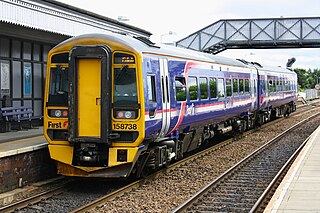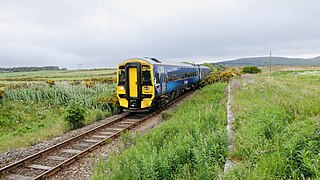Related Research Articles

First ScotRail was a train operating company in Scotland owned by FirstGroup which operated the ScotRail franchise from October 2004 until March 2015. Prior to October 2004, trains were run by ScotRail. First ScotRail was succeeded by Abellio ScotRail on 1 April 2015.

The Highland Railway (HR) was one of the smaller British railways before the Railways Act 1921, operating north of Perth railway station in Scotland and serving the farthest north of Britain. Based in Inverness, the company was formed by merger in 1865, absorbing over 249 miles (401 km) of line. It continued to expand, reaching Wick and Thurso in the north and Kyle of Lochalsh in the west, eventually serving the counties of Caithness, Sutherland, Ross & Cromarty, Inverness, Perth, Nairn, Moray and Banff. Southward it connected with the Caledonian Railway at Stanley Junction, north of Perth, and eastward with the Great North of Scotland Railway at Boat of Garten, Elgin, Keith and Portessie.

Kyle of Lochalsh is a village in the historic county of Ross-shire on the northwest coast of Scotland, located around 55 miles (90 km) west-southwest of Inverness. It is located on the Lochalsh peninsula, at the entrance to Loch Alsh, opposite the village of Kyleakin on the Isle of Skye. A ferry used to connect the two villages until it was replaced by the Skye Bridge, about a mile (2 km) to the west, in 1995.

The Highland Main Line is a railway line in Scotland. It is 118 mi (190 km) long and runs through the Scottish Highlands linking a series of small towns and villages with Perth at one end and Inverness at the other. Today, services between Inverness and Edinburgh, Glasgow and London use the line. At Inverness the line connects with the Far North Line, the Aberdeen-Inverness Line and services on the Kyle of Lochalsh Line. All trains are diesel-powered.

The Kyle of Lochalsh Line is a primarily single track railway line in the Scottish Highlands, from Dingwall to Kyle of Lochalsh. Many of the passengers are tourists, but there are also locals visiting Inverness for shopping, and commuters. All services are provided by ScotRail and run beyond Dingwall to Inverness. In the past there were some through services to and from Glasgow, Edinburgh or Aberdeen. None of the line is electrified, and all trains on the line are diesel-powered, as are all other trains in the Scottish Highlands.

The Far North Line is a rural railway line entirely within the Highland area of Scotland, extending from Inverness to Thurso and Wick. As the name suggests, it is the northernmost railway in the United Kingdom. The line is entirely single-track, with only crossing loops at some intermediate stations allowing trains to pass each other. In common with other railway lines in the Highlands and northern Lowlands, it is not electrified and all trains are diesel-powered.

Dingwall railway station serves Dingwall, Scotland. It is located just south of the junction of the Far North Line and the Kyle of Lochalsh Line, and is served by ScotRail. The station is 18 miles 58 chains (30.1 km) from Inverness, and is the zero point for the Kyle of Lochalsh Line. It is sited after Conon Bridge heading northbound, with the next station being either Garve or Alness.

Inverness railway station is the railway station serving the Scottish city of Inverness. It is the terminus of the Highland Main Line, the Aberdeen–Inverness line, the Kyle of Lochalsh line and the Far North Line.
The Scottish Region (ScR) was one of the six regions created on British Railways (BR) and consisted of ex-London, Midland and Scottish Railway (LMS) and ex-London and North Eastern Railway (LNER) lines in Scotland. It existed from the creation of BR in 1948, and was renamed to ScotRail in the mid-1980s.

Caledonian Sleeper is the collective name for overnight sleeper train services between London and Scotland, in the United Kingdom. It is one of only two currently operating sleeper services on the railway in the United Kingdom, the other being the Night Riviera which runs between London and Penzance.

Garve railway station is a railway station on the Kyle of Lochalsh Line, serving the village of Garve in the north of Scotland. Garve is located at the eastern edge of Loch Garve. It was to be the junction for the Garve and Ullapool Railway, intended to connect Ullapool, the Western Isles' nearest mainland port, with the rest of the UK. An act of parliament was passed for the line in 1890, but in spite of local efforts in that year, and again two years later, the idea could not be fully financed and was abandoned.

Achnasheen railway station is a remote railway station on the Kyle of Lochalsh Line, serving the village of Achnasheen in the north of Scotland.

Kyle of Lochalsh railway station is the terminus of the Kyle of Lochalsh Line in the village of Kyle of Lochalsh in the Highlands, northern Scotland.

Nairn railway station is a railway station serving the town of Nairn in Scotland. The station is managed by ScotRail and is on the Aberdeen to Inverness Line. It is a category B listed building. The station appeared as 'Inverness' in the 1970 film The Private Life of Sherlock Holmes.

Forres railway station serves the town of Forres, Moray in Scotland. The station is managed by ScotRail and is on the Aberdeen–Inverness line.

Elgin railway station is a railway station serving the town of Elgin, Moray in Scotland. The station is managed by ScotRail and is on the Aberdeen to Inverness Line.
The Dingwall and Skye Railway was authorised on 5 July 1865 with the aim of providing a route to Skye and the Hebrides. However, due to local objections, another Act of Parliament was required before work could commence. This was passed on 29 May 1868.

Conon Bridge is a railway station on the Far North and Kyle of Lochalsh Lines, which serves the villages of Conon Bridge and Maryburgh in the Scottish Highlands. Initially known as Conon, it originally closed in 1960 and reopened on 8 February 2013. The station is 16 miles 21 chains (26.2 km) from Inverness, between Muir of Ord and Dingwall.

Strathpeffer railway station was a railway station serving the town of Strathpeffer in the county of Ross and Cromarty,, Scotland. The first station was located some distance from the town, on the Dingwall and Skye Railway line, and was opened in 1870.
The Hebridean was a named passenger train operating in the United Kingdom.
References
- ↑ Allen, Cecil J. (1967). Titled Trains of Great Britain. Ian Allan Ltd. p. 95.
- ↑ "Scots names for Scots trains" . Shields Daily News. England. 13 June 1933. Retrieved 25 November 2017– via British Newspaper Archive.
- ↑ Nock, Oswald Stevens (1961). Scottish Railways. T. Nelson.